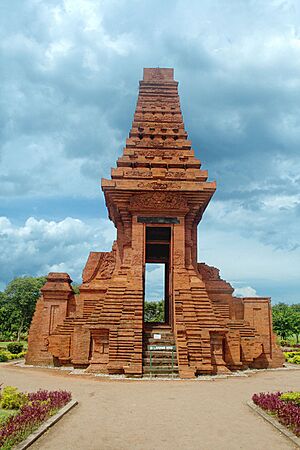Jayanegara facts for kids
Quick facts for kids Jayanagara |
|||||
|---|---|---|---|---|---|
| Maharaja of Majapahit Bhre Daha |
|||||
| 2nd Great King of Majapahit | |||||
| Reign | 1309 – 1328 | ||||
| Predecessor | Kertarajasa Jayawardhana Dyah Wijaya | ||||
| Successor | Tribhuwana Tunggadewi Dyah Tya | ||||
| 1st Prince of Daha | |||||
| Reign | 1295 – 1309 | ||||
| Successor | Rajadewi Maharajasa Dyah Wiyat | ||||
| Died | 1328 Kingdom of Majapahit |
||||
| Burial | Kapopongan Palace, Antawulan, Kingdom of Majapahit | ||||
|
|||||
| House | Rajasa | ||||
| Father | King Kertarajasa Jayawardhana Dyah Wijaya | ||||
| Mother | Indreswari (biological) Tribhuwaneswari (adoptive) |
||||
| Religion | Hinduism | ||||
Jayanagara was the second ruler of the powerful Majapahit Empire in Java. He reigned as king from 1309 until his death in 1328. Before becoming king, he was a prince in Kediri starting from 1295.
Jayanagara was the only son of Raden Wijaya, who founded the Majapahit Empire. His life story is found in old records like the Pararaton and Negarakertagama. During his time as king, a very important figure named Gajah Mada began to gain power and influence in the empire.
Who was Jayanagara?
Jayanagara was the son of King Kertarajasa Jayawardhana, also known as Dyah Wijaya. His name comes from ancient Javanese words. Jaya means "glorious," and nagara means "city" or "nation." So, his name means "glorious nation."
There are different ideas about who Jayanagara's mother was. Some old writings say his mother was Queen Tribhuwaneswari. This would have made him the clear heir to the throne. However, other records, like the Pararaton and Nagarakretagama, say his mother was Dara Petak. She was a princess from the Malayu Dharmasraya Kingdom in Sumatra.
To make sense of these different stories, some historians think that Jayanagara was Dara Petak's biological son. But he might have been adopted by Queen Tribhuwaneswari, who did not have her own children. This way, he was raised as her son and became the crown prince.
Jayanagara's Time as King
Jayanagara's time as king was quite challenging. He faced several rebellions from people who used to be his father's friends and allies. One important rebellion was led by Kuti in 1319. This was very serious because Kuti's forces took over the palace and the capital city of Majapahit.
King Jayanagara had to escape the capital. He was helped by Gajah Mada, who was then a leader of the palace guard. Gajah Mada helped the king hide safely in a village called Badander. While the king was in hiding, Gajah Mada secretly went back to the capital. He wanted to find out what was happening.
Gajah Mada learned that most people and nobles did not support Kuti's rebellion. So, Gajah Mada led the forces that fought against Kuti. They successfully defeated the rebels. After this, King Jayanagara could safely return to his throne. Because of his loyalty and great service, Gajah Mada was given a higher position. This was the start of his important career in the royal court.
Jayanagara was sometimes called Kala Gemet. This nickname was given to him by the writer of the Pararaton. Some people in Java did not fully accept him as a true Javanese ruler. This was partly because his biological mother was from Sumatra. Also, he was not the son of any of the daughters of the previous king, Kertanegara. This made some question his right to the throne.
He also sent official messengers to China between 1325 and 1328.
The King's Death
In 1328, King Jayanagara was murdered by his own doctor, named Tanca. This happened during a small medical procedure. Right after the murder, Gajah Mada quickly punished and killed Tanca. The exact reasons behind Jayanagara's assassination are still a mystery.
One idea is that Gajah Mada might have planned the assassination. Gajah Mada was a very loyal advisor to Princess Tribhuwana Wijayatunggadewi. King Jayanagara did not have any children when he died. This meant there was no direct heir to the throne. So, the throne would pass to one of his siblings.
Gayatri Rajapatni, who was Raden Wijaya's first wife, was supposed to become queen. However, she had become a Buddhist nun (bhikkhuni). This meant she could not hold political power. So, her daughter, Tribhuwana (Tribhuwana Wijayatunggadewi), became the regent instead. A regent rules on behalf of the rightful ruler. By 1330, Tribhuwana married Chakradhara, who became Prince of Singhasari. Their son, Hayam Wuruk, was born in 1334. He later became a very famous king in 1350.
The Bajang Ratu gate in Trowulan is an old structure linked to Jayanagara. People believe this gate was part of a special place built to honor the soul of the late King Jayanagara.


